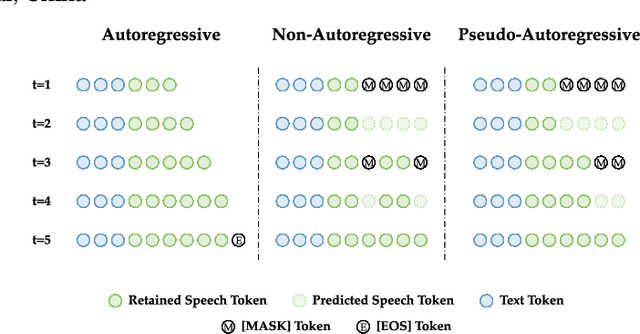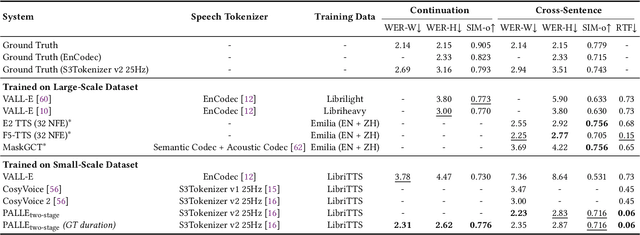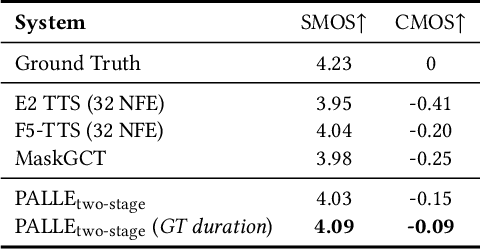Haiyang Sun
Pixel-Perfect Depth with Semantics-Prompted Diffusion Transformers
Oct 08, 2025Abstract:This paper presents Pixel-Perfect Depth, a monocular depth estimation model based on pixel-space diffusion generation that produces high-quality, flying-pixel-free point clouds from estimated depth maps. Current generative depth estimation models fine-tune Stable Diffusion and achieve impressive performance. However, they require a VAE to compress depth maps into latent space, which inevitably introduces \textit{flying pixels} at edges and details. Our model addresses this challenge by directly performing diffusion generation in the pixel space, avoiding VAE-induced artifacts. To overcome the high complexity associated with pixel-space generation, we introduce two novel designs: 1) Semantics-Prompted Diffusion Transformers (SP-DiT), which incorporate semantic representations from vision foundation models into DiT to prompt the diffusion process, thereby preserving global semantic consistency while enhancing fine-grained visual details; and 2) Cascade DiT Design that progressively increases the number of tokens to further enhance efficiency and accuracy. Our model achieves the best performance among all published generative models across five benchmarks, and significantly outperforms all other models in edge-aware point cloud evaluation.
Uncovering and Mitigating Destructive Multi-Embedding Attacks in Deepfake Proactive Forensics
Aug 24, 2025Abstract:With the rapid evolution of deepfake technologies and the wide dissemination of digital media, personal privacy is facing increasingly serious security threats. Deepfake proactive forensics, which involves embedding imperceptible watermarks to enable reliable source tracking, serves as a crucial defense against these threats. Although existing methods show strong forensic ability, they rely on an idealized assumption of single watermark embedding, which proves impractical in real-world scenarios. In this paper, we formally define and demonstrate the existence of Multi-Embedding Attacks (MEA) for the first time. When a previously protected image undergoes additional rounds of watermark embedding, the original forensic watermark can be destroyed or removed, rendering the entire proactive forensic mechanism ineffective. To address this vulnerability, we propose a general training paradigm named Adversarial Interference Simulation (AIS). Rather than modifying the network architecture, AIS explicitly simulates MEA scenarios during fine-tuning and introduces a resilience-driven loss function to enforce the learning of sparse and stable watermark representations. Our method enables the model to maintain the ability to extract the original watermark correctly even after a second embedding. Extensive experiments demonstrate that our plug-and-play AIS training paradigm significantly enhances the robustness of various existing methods against MEA.
Step-Audio 2 Technical Report
Jul 24, 2025Abstract:This paper presents Step-Audio 2, an end-to-end multi-modal large language model designed for industry-strength audio understanding and speech conversation. By integrating a latent audio encoder and reasoning-centric reinforcement learning (RL), Step-Audio 2 achieves promising performance in automatic speech recognition (ASR) and audio understanding. To facilitate genuine end-to-end speech conversation, Step-Audio 2 incorporates the generation of discrete audio tokens into language modeling, significantly enhancing its responsiveness to paralinguistic information such as speaking styles and emotions. To effectively leverage the rich textual and acoustic knowledge in real-world data, Step-Audio 2 integrates retrieval-augmented generation (RAG) and is able to call external tools such as web search to mitigate hallucination and audio search to switch timbres. Trained on millions of hours of speech and audio data, Step-Audio 2 delivers intelligence and expressiveness across diverse conversational scenarios. Evaluation results demonstrate that Step-Audio 2 achieves state-of-the-art performance on various audio understanding and conversational benchmarks compared to other open-source and commercial solutions. Please visit https://github.com/stepfun-ai/Step-Audio2 for more information.
DiffMark: Diffusion-based Robust Watermark Against Deepfakes
Jul 02, 2025Abstract:Deepfakes pose significant security and privacy threats through malicious facial manipulations. While robust watermarking can aid in authenticity verification and source tracking, existing methods often lack the sufficient robustness against Deepfake manipulations. Diffusion models have demonstrated remarkable performance in image generation, enabling the seamless fusion of watermark with image during generation. In this study, we propose a novel robust watermarking framework based on diffusion model, called DiffMark. By modifying the training and sampling scheme, we take the facial image and watermark as conditions to guide the diffusion model to progressively denoise and generate corresponding watermarked image. In the construction of facial condition, we weight the facial image by a timestep-dependent factor that gradually reduces the guidance intensity with the decrease of noise, thus better adapting to the sampling process of diffusion model. To achieve the fusion of watermark condition, we introduce a cross information fusion (CIF) module that leverages a learnable embedding table to adaptively extract watermark features and integrates them with image features via cross-attention. To enhance the robustness of the watermark against Deepfake manipulations, we integrate a frozen autoencoder during training phase to simulate Deepfake manipulations. Additionally, we introduce Deepfake-resistant guidance that employs specific Deepfake model to adversarially guide the diffusion sampling process to generate more robust watermarked images. Experimental results demonstrate the effectiveness of the proposed DiffMark on typical Deepfakes. Our code will be available at https://github.com/vpsg-research/DiffMark.
Genesis: Multimodal Driving Scene Generation with Spatio-Temporal and Cross-Modal Consistency
Jun 09, 2025Abstract:We present Genesis, a unified framework for joint generation of multi-view driving videos and LiDAR sequences with spatio-temporal and cross-modal consistency. Genesis employs a two-stage architecture that integrates a DiT-based video diffusion model with 3D-VAE encoding, and a BEV-aware LiDAR generator with NeRF-based rendering and adaptive sampling. Both modalities are directly coupled through a shared latent space, enabling coherent evolution across visual and geometric domains. To guide the generation with structured semantics, we introduce DataCrafter, a captioning module built on vision-language models that provides scene-level and instance-level supervision. Extensive experiments on the nuScenes benchmark demonstrate that Genesis achieves state-of-the-art performance across video and LiDAR metrics (FVD 16.95, FID 4.24, Chamfer 0.611), and benefits downstream tasks including segmentation and 3D detection, validating the semantic fidelity and practical utility of the generated data.
ReCogDrive: A Reinforced Cognitive Framework for End-to-End Autonomous Driving
Jun 09, 2025Abstract:Although end-to-end autonomous driving has made remarkable progress, its performance degrades significantly in rare and long-tail scenarios. Recent approaches attempt to address this challenge by leveraging the rich world knowledge of Vision-Language Models (VLMs), but these methods suffer from several limitations: (1) a significant domain gap between the pre-training data of VLMs and real-world driving data, (2) a dimensionality mismatch between the discrete language space and the continuous action space, and (3) imitation learning tends to capture the average behavior present in the dataset, which may be suboptimal even dangerous. In this paper, we propose ReCogDrive, an autonomous driving system that integrates VLMs with diffusion planner, which adopts a three-stage paradigm for training. In the first stage, we use a large-scale driving question-answering datasets to train the VLMs, mitigating the domain discrepancy between generic content and real-world driving scenarios. In the second stage, we employ a diffusion-based planner to perform imitation learning, mapping representations from the latent language space to continuous driving actions. Finally, we fine-tune the diffusion planner using reinforcement learning with NAVSIM non-reactive simulator, enabling the model to generate safer, more human-like driving trajectories. We evaluate our approach on the planning-oriented NAVSIM benchmark, achieving a PDMS of 89.6 and setting a new state-of-the-art that surpasses the previous vision-only SOTA by 5.6 PDMS.
Zero-Shot Streaming Text to Speech Synthesis with Transducer and Auto-Regressive Modeling
May 26, 2025Abstract:Zero-shot streaming text-to-speech is an important research topic in human-computer interaction. Existing methods primarily use a lookahead mechanism, relying on future text to achieve natural streaming speech synthesis, which introduces high processing latency. To address this issue, we propose SMLLE, a streaming framework for generating high-quality speech frame-by-frame. SMLLE employs a Transducer to convert text into semantic tokens in real time while simultaneously obtaining duration alignment information. The combined outputs are then fed into a fully autoregressive (AR) streaming model to reconstruct mel-spectrograms. To further stabilize the generation process, we design a Delete < Bos > Mechanism that allows the AR model to access future text introducing as minimal delay as possible. Experimental results suggest that the SMLLE outperforms current streaming TTS methods and achieves comparable performance over sentence-level TTS systems. Samples are available on https://anonymous.4open.science/w/demo_page-48B7/.
PosePilot: Steering Camera Pose for Generative World Models with Self-supervised Depth
May 03, 2025Abstract:Recent advancements in autonomous driving (AD) systems have highlighted the potential of world models in achieving robust and generalizable performance across both ordinary and challenging driving conditions. However, a key challenge remains: precise and flexible camera pose control, which is crucial for accurate viewpoint transformation and realistic simulation of scene dynamics. In this paper, we introduce PosePilot, a lightweight yet powerful framework that significantly enhances camera pose controllability in generative world models. Drawing inspiration from self-supervised depth estimation, PosePilot leverages structure-from-motion principles to establish a tight coupling between camera pose and video generation. Specifically, we incorporate self-supervised depth and pose readouts, allowing the model to infer depth and relative camera motion directly from video sequences. These outputs drive pose-aware frame warping, guided by a photometric warping loss that enforces geometric consistency across synthesized frames. To further refine camera pose estimation, we introduce a reverse warping step and a pose regression loss, improving viewpoint precision and adaptability. Extensive experiments on autonomous driving and general-domain video datasets demonstrate that PosePilot significantly enhances structural understanding and motion reasoning in both diffusion-based and auto-regressive world models. By steering camera pose with self-supervised depth, PosePilot sets a new benchmark for pose controllability, enabling physically consistent, reliable viewpoint synthesis in generative world models.
SIDME: Self-supervised Image Demoiréing via Masked Encoder-Decoder Reconstruction
Apr 16, 2025Abstract:Moir\'e patterns, resulting from aliasing between object light signals and camera sampling frequencies, often degrade image quality during capture. Traditional demoir\'eing methods have generally treated images as a whole for processing and training, neglecting the unique signal characteristics of different color channels. Moreover, the randomness and variability of moir\'e pattern generation pose challenges to the robustness of existing methods when applied to real-world data. To address these issues, this paper presents SIDME (Self-supervised Image Demoir\'eing via Masked Encoder-Decoder Reconstruction), a novel model designed to generate high-quality visual images by effectively processing moir\'e patterns. SIDME combines a masked encoder-decoder architecture with self-supervised learning, allowing the model to reconstruct images using the inherent properties of camera sampling frequencies. A key innovation is the random masked image reconstructor, which utilizes an encoder-decoder structure to handle the reconstruction task. Furthermore, since the green channel in camera sampling has a higher sampling frequency compared to red and blue channels, a specialized self-supervised loss function is designed to improve the training efficiency and effectiveness. To ensure the generalization ability of the model, a self-supervised moir\'e image generation method has been developed to produce a dataset that closely mimics real-world conditions. Extensive experiments demonstrate that SIDME outperforms existing methods in processing real moir\'e pattern data, showing its superior generalization performance and robustness.
Pseudo-Autoregressive Neural Codec Language Models for Efficient Zero-Shot Text-to-Speech Synthesis
Apr 14, 2025



Abstract:Recent zero-shot text-to-speech (TTS) systems face a common dilemma: autoregressive (AR) models suffer from slow generation and lack duration controllability, while non-autoregressive (NAR) models lack temporal modeling and typically require complex designs. In this paper, we introduce a novel pseudo-autoregressive (PAR) codec language modeling approach that unifies AR and NAR modeling. Combining explicit temporal modeling from AR with parallel generation from NAR, PAR generates dynamic-length spans at fixed time steps. Building on PAR, we propose PALLE, a two-stage TTS system that leverages PAR for initial generation followed by NAR refinement. In the first stage, PAR progressively generates speech tokens along the time dimension, with each step predicting all positions in parallel but only retaining the left-most span. In the second stage, low-confidence tokens are iteratively refined in parallel, leveraging the global contextual information. Experiments demonstrate that PALLE, trained on LibriTTS, outperforms state-of-the-art systems trained on large-scale data, including F5-TTS, E2-TTS, and MaskGCT, on the LibriSpeech test-clean set in terms of speech quality, speaker similarity, and intelligibility, while achieving up to ten times faster inference speed. Audio samples are available at https://anonymous-palle.github.io.
 Add to Chrome
Add to Chrome Add to Firefox
Add to Firefox Add to Edge
Add to Edge